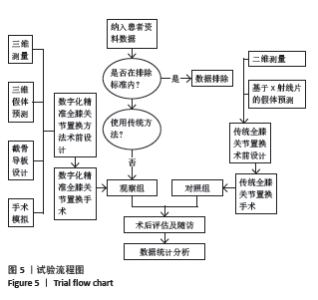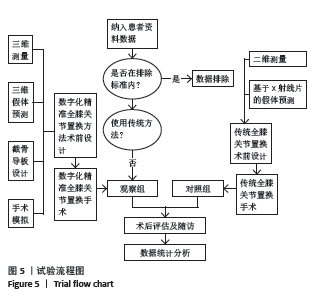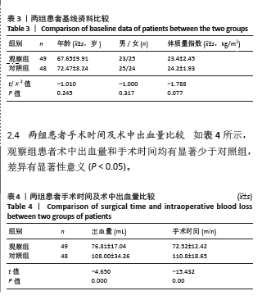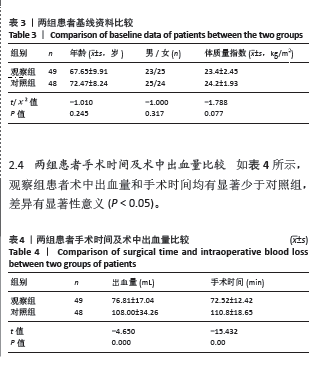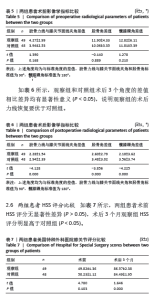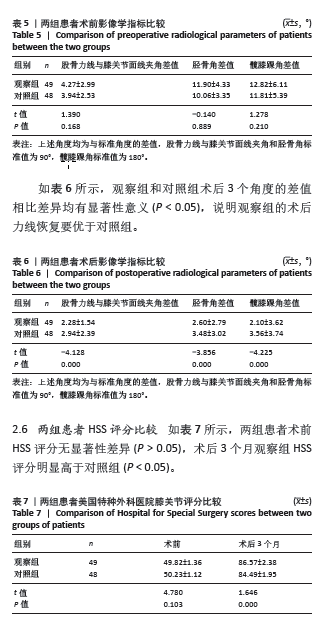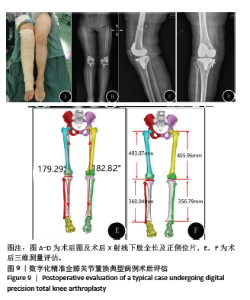Chinese Journal of Tissue Engineering Research ›› 2025, Vol. 29 ›› Issue (21): 4521-4528.doi: 10.12307/2025.188
Previous Articles Next Articles
Comparison of short-term therapeutic effects between digital precision total knee arthroplasty and traditional methods
Wang Yuning1, Zhu Haotian1, Liu Kang1, Ding Huanwen1, 2, Yan Han2
- 1South China University of Technology, Guangzhou 510006, Guangdong Province, China; 2Guangzhou First People's Hospital, Guangzhou 510180, Guangdong Province, China
-
Received:2024-03-05Accepted:2024-05-06Online:2025-07-28Published:2024-12-06 -
Contact:Ding Huanwen, PhD, Professor, South China University of Technology, Guangzhou 510006, Guangdong Province, China; Guangzhou First People's Hospital, Guangzhou 510180, Guangdong Province, China -
About author:Wang Yuning, Master candidate, South China University of Technology, Guangzhou 510006, Guangdong Province, China -
Supported by:Guangdong Province Basic and Applied Basic Research Fund Project, No. 2021A1515012564, 2023A1515010557 (to DHW); Guangdong Provincial Science and Technology Plan Project, No. 2017B090911008 (to DHW); Science and Technology Plan Fund of Guangdong Provincial Department of Science and Technology, No. 2023A03j0957 (to YH); Key Project of Guangzhou Health Commission in Guangdong Province, No. 2023C-TS20 (to YH)
CLC Number:
Cite this article
Wang Yuning, Zhu Haotian, Liu Kang, Ding Huanwen, Yan Han. Comparison of short-term therapeutic effects between digital precision total knee arthroplasty and traditional methods[J]. Chinese Journal of Tissue Engineering Research, 2025, 29(21): 4521-4528.
share this article
Add to citation manager EndNote|Reference Manager|ProCite|BibTeX|RefWorks

2.8 典型病例 66岁女性患者,自述双膝部反复疼痛5年,行动不便。入院行影像学检查提示双膝骨关节炎,住院拟行右TKA术。查体:左膝关节术后瘢痕,右膝关节轻压痛,主动屈伸活动受限,被动屈伸活动轻度受限,肢端皮肤感觉,血运正常,足趾活动良好。 X射线片检查:可见左TKA术后,右膝内翻畸形改变,膝关节面磨损明显、模糊、不整、间隙变窄,左侧髌骨明显周缘骨质增生。 CT检查:可见左TKA术后,右膝内翻畸形改变,膝关节面磨损明显、间隙变窄,膝关节面下方可见斑点状及小囊状密度减低。右侧髌骨及右膝关节间隙周缘骨质增生。 治疗前HSS评分为48.3分,股骨角为84.26°,胫骨角为73.22°,髋膝踝角为196.16°。测得右股骨左右径73.039 6 mm,前后径62.727 6 mm;右胫骨左右径74.005 4 mm,前后径52.303 8 mm。 根据测量数据预测右股骨髁为施乐辉6号假体匹配最佳,右胫骨的胫骨平台为6号胫骨平台假体最佳。在3D打印个性化截骨导板辅助下进行人工TKA术,治疗后股骨力线和膝关节面线夹角为88.30°,胫骨角为88.93°,髋膝踝角为179.29°。治疗后3个月随访HSS评分为86.7分,膝关节疼痛缓解,关节功能明显改善。图6为术前外观,图7为术前设计的截骨导板实物图,图8为手术过程图,图9为术后评估图。 2.9 不良事件 两组患者术后均无严重并发症出现,部分患者足踝、足背肿胀,经过B超排除深静脉栓塞,采用平卧小腿垫高,踝关节练习,口服抗凝药物后消失。因此并发症不做统计学分析。 2.10 植入物与宿主的生物相容性 此次研究中患者均未出现植入物周围感染、过敏、免疫反应及排斥反应。 "
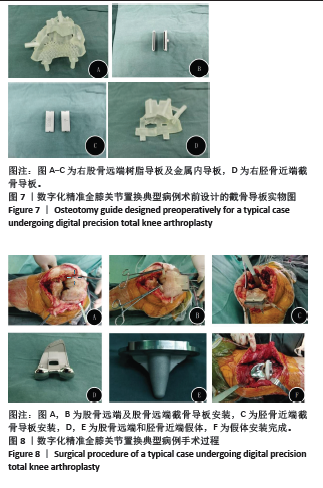
| [1] SADOGHI P, LIEBENSTEINER M, AGREITER M, et al. Revision surgery after total joint arthroplasty: a complication-based analysis using worldwide arthroplasty registers. J Arthroplasty. 2013;28(8):1329-1332. [2] KARASAVVIDIS T, PAGAN MOLDENHAUER CA, LUSTIG S, et al. Definitions and consequences of current alignment techniques and phenotypes in total knee arthroplasty (TKA) - there is no winner yet. J Exp Orthop. 2023;10(1):120. [3] LE DH, GOODMAN SB, MALONEY WJ, et al. Current modes of failure in TKA: infection, instability, and stiffness predominate. Clin Orthop Relat Res. 2014;472(7):2197-200. [4] CHEN JW, KUO FC, KUO SJ, et al. Avoidance of intramedullary violation in computer-assisted total knee arthroplasty lowers the incidence of periprosthetic joint infection compared with conventional total knee arthroplasty: A propensity score matching analysis of 5342 cases. Knee. 2022;35:164-174. [5] 张进, 孙立, 杨先腾, 等. 数字化模拟技术应用于全膝关节置换术前假体尺寸预测的临床探讨[J]. 上海交通大学学报 (医学版),2016,36(9): 1292-1296. [6] KESKINIS A, PARASKEVOPOULOS K, DIAMANTIDIS DE, et al. The Role of 3D-Printed Patient-Specific Instrumentation in Total Knee Arthroplasty: A Literature Review. Cureus. 2023;15(8):e43321. [7] 陈拥,王增辉,朴成哲.3D打印个性化截骨导板辅助行全膝关节置换的应用[J].中国组织工程研究,2019,23(8):1155-1160. [8] 高嘉翔, 邢丹, 林剑浩. 下肢力线的测量及其在全膝关节置换术中的应用[J]. 中华外科杂志,2020,58(6):478-480. [9] 石威,严伟,余昕,等.3D打印截骨导板辅助人工全膝关节置换术在重度膝内翻畸形中的应用观察.蚌埠医学院学报,2022,47(10):1401-1406. [10] ZHENG K, SUN H, ZHANG W, et al. Mid-Term Outcomes of Navigation-Assisted Primary Total Knee Arthroplasty Using Adjusted Mechanical Alignment. Orthop Surg. 2023;15(1):230-238. [11] NAM D, MCARTHUR BA, CROSS MB, et al. Patient-specific instrumentation in total knee arthroplasty: a review. J Knee Surg. 2012;25(3):213-219. [12] BLAGOJEVIC M, JINKS C, JEFFERY A, et al. Risk factors for onset of osteoarthritis of the knee in older adults: a systematic review and meta-analysis. Osteoarthritis Cartilage. 2010;18(1):24-33. [13] ONUORA S. Osteoarthritis: Arthroscopy does not delay TKA for knee OA. Nat Rev Rheumatol. 2018;14(2):62. [14] LE STUM M, GICQUEL T, DARDENNE G, et al. Total knee arthroplasty in France: Male-driven rise in procedures in 2009-2019 and projections for 2050. Orthop Traumatol Surg Res. 2023;109(5):103463. [15] ERIVAN R, TARDIEU A, VILLATTE G, et al. Knee surgery trends and projections in France from 2008 to 2070. Orthop Traumatol Surg Res. 2020;106(5):893-902. [16] MARADIT KREMERS H, LARSON DR, CROWSON CS, et al. Prevalence of Total Hip and Knee Replacement in the United States. J Bone Joint Surg Am. 2015;97(17):1386-1397. [17] HAWKER GA, BOHM E, DUNBAR MJ, et al. The Effect of Patient Age and Surgical Appropriateness and Their Influence on Surgeon Recommendations for Primary TKA: A Cross-Sectional Study of 2,037 Patients. J Bone Joint Surg Am. 2022;104(8):700-708. [18] 刘发泰, 杨进顺, 钟伟斌. 3D 截骨导板在合并股骨畸形膝关节骨性关节炎患者膝关节置换中的应用[J]. 中国组织工程研究,2022,26(15): 2312-2316. [19] PARK A, NAM D, FRIEDMAN MV, et al. Inter-observer precision and physiologic variability of mri landmarks used to determine rotational alignment in conventional and patient-specific TKA. J Arthroplasty. 2015; 30(2):290-295. [20] HOORNTJE A, WITJES S, KOENRAADT KLM, et al. More Severe Preoperative Kellgren-Lawrence Grades of Knee Osteoarthritis were Partially Associated with Better Postoperative Patient-Reported Outcomes in TKA Patients. J Knee Surg. 2019;32(3):211-217. [21] 郭盛杰, 张洪, 李玉军, 等. 全膝关节置换术前模板测量预测术中假体型号: 92 例资料回顾[J]. 中国组织工程研究与临床康复,2007,11(40): 8070-8073. [22] CARPENTIER A, LOULMET D, AUPECLE B, et al. Computer-assisted cardiac surgery. Lancet. 1999;353(9150):379-380. [23] RADTKE A, SOTIROPOULOS GC, MOLMENTI EP, et al. Computer-assisted surgery planning for complex liver resections: when is it helpful? A single-center experience over an 8-year period. Ann Surg. 2010;252(5):876-883. [24] MERLOZ P, TONETTI J, PITTET L, et al. Computer-assisted spine surgery. Comput Aided Surg. 1998;3(6):297-305. [25] BÄTHIS H, PERLICK L, TINGART M, et al. Alignment in total knee arthroplasty. A comparison of computer-assisted surgery with the conventional technique. J Bone Joint Surg Br. 2004;86(5):682-687. [26] HEINZ T, EIDMANN A, ANDERSON P, et al. Trends in Computer-Assisted Surgery for Total Knee Arthroplasty in Germany: An Analysis Based on the Operative Procedure Classification System between 2010 to 2021. J Clin Med. 2023;12(2):549. [27] STÜBIG T, WINDHAGEN H, KRETTEK C, et al. Computer-Assisted Orthopedic and Trauma Surgery. Dtsch Arztebl Int. 2020;117(47):793-800. [28] SINGLA A, MALHOTRA R, KUMAR V, et al. A Randomized Controlled Study to Compare the Total and Hidden Blood Loss in Computer-Assisted Surgery and Conventional Surgical Technique of Total Knee Replacement. Clin Orthop Surg. 2015;7(2):211-216. [29] GAUKEL S, VUILLE-DIT-BILLE RN, SCHLÄPPI M, et al. CT-based patient-specific instrumentation for total knee arthroplasty in over 700 cases: single-use instruments are as accurate as standard instruments. Knee Surg Sports Traumatol Arthrosc. 2022;30(2):447-455. [30] WU Q, YU T, LEI B, et al. A New Individualized Three-Dimensional Printed Template for Lateral Ankle Ligament Reconstruction. Med Sci Monit. 2020; 26:e922925. [31] ROSSI R, COTTINO U, BRUZZONE M, et al. Total knee arthroplasty in the varus knee: tips and tricks. Int Orthop. 2019;43(1):151-158. [32] REZAEI A, MOON J, LICHTIG A, et al. Precision soft tissue balancing: grid-assisted pie-crusting in total knee arthroplasty. Front Surg. 2024;11: 1331902. [33] FOO WYX, CHEN JY, PANG HN, et al. Severe genu varus deformity does not affect enhanced recovery after surgery total knee arthroplasty outcomes. Arch Orthop Trauma Surg. 2024. doi: 10.1007/s00402-024-05280-y. [34] UMRE A, WAKDE O, MEGHARE R. Are soft tissue releases sufficient to correct moderate to severe flexion contractures during total knee replacement? Role of hamstring tenotomy and horizontal capsular release. Knee. 2022;39:291-299. [35] XU HT, DONG JT, WANG J, et al. Surgical Technique of Total Knee Arthroplasty without Soft Tissue Balance. Orthop Surg. 2016;8(4):519-522. [36] HAMILTON DA, ONONUJU U, NOWAK C, et al. Differences in Immediate Postoperative Outcomes Between Robotic-Assisted TKA and Conventional TKA. Arthroplast Today. 2021;8:57-62. [37] ROMAN MD, RUSSU O, MOHOR C, et al. Outcomes in revision total knee arthroplasty (Review). Exp Ther Med. 2022;23(1):29. [38] VAIDYA NV, DESHPANDE AN, PANJWANI T, et al. Robotic-assisted TKA leads to a better prosthesis alignment and a better joint line restoration as compared to conventional TKA: a prospective randomized controlled trial. Knee Surg Sports Traumatol Arthrosc. 2022;30(2):621-626. [39] LADDHA M, GAURAV S. Assessment of Limb Alignment and Component Placement After All Burr Robotic-Assisted TKA. Indian J Orthop. 2020; 55(Suppl 1):69-75. [40] CLATWORTHY M. Patient-Specific TKA with the VELYS™ Robotic-Assisted Solution. Surg Technol Int. 2022;40:315-320. [41] INDELLI PF, SALVI AG, PETRALIA G. Editorial: Alignment options and robotics in total knee arthroplasty (TKA) “Alignment, alignment, alignment, but TKA fail mainly for infections and instability”. Front Surg. 2023;10:1247759. [42] WINNOCK DE GRAVE P, KELLENS J, et al. Clinical outcomes in TKA are enhanced by both robotic assistance and patient specific alignment: a comparative trial in 120 patients. Arch Orthop Trauma Surg. 2023;143(6): 3391-3399. |
| [1] | Ma Chi, Wang Ning, Chen Yong, Wei Zhihan, Liu Fengji, Piao Chengzhe. Application of 3D-printing patient-specific instruments combined with customized locking plate in opening wedge high tibial osteotomy [J]. Chinese Journal of Tissue Engineering Research, 2025, 29(9): 1863-1869. |
| [2] | Zhou Jinhai, Li Jiangwei, Wang Xuquan, Zhuang Ying, Zhao Ying, Yang Yuyong, Wang Jiajia, Yang Yang, Zhou Shilian. Three-dimensional finite element analysis of anterior femoral notching during total knee arthroplasty at different bone strengths [J]. Chinese Journal of Tissue Engineering Research, 2025, 29(9): 1775-1782. |
| [3] | Zhang Yu, Xu Ruian, Fang Lei, Li Longfei, Liu Shuyan, Ding Lingxue, Wang Yuexi, Guo Ziyan, Tian Feng, Xue Jiajia. Gradient artificial bone repair scaffold regulates skeletal system tissue repair and regeneration [J]. Chinese Journal of Tissue Engineering Research, 2025, 29(4): 846-855. |
| [4] | Hu Chaoran, Cen Chaode, Yang Yang, Zhou Cheng, Huang Huaxian, Yuan Honghao, Luo Qin, Cao Yongfei. 3D printing assisted minimal invasive plate osteosynthesis versus intramedullary nail for treatment of AO12-C middle-proximal humeral fractures [J]. Chinese Journal of Tissue Engineering Research, 2025, 29(33): 7116-7122. |
| [5] | Li Guoliang, Zhao Jianyong, Lyu Deliang, Su Juyue, Liu Qilin, Wang Tieqiang, Wang Xin. Improved 3D printed splint for distal radius fracture based on clinical defects: design and rapid grid-free analysis [J]. Chinese Journal of Tissue Engineering Research, 2025, 29(33): 7123-7129. |
| [6] | Wei Zhiheng, Guan Tianmin, Liu Qing, Gong Jue, Xiang Xianxiang. Application of 3D printing accurate osteotomy guide combined with the revision of anterior cruciate ligament with abnormally increased posterior slope of tibial plateau [J]. Chinese Journal of Tissue Engineering Research, 2025, 29(33): 7130-7136. |
| [7] | Jiang Tao, Zhang Chuankai, Hao Liang, Liu Yong. MAKO robot- and navigation-assisted knee replacement: comparison of lower limb force alignment and prosthesis position accuracy [J]. Chinese Journal of Tissue Engineering Research, 2025, 29(33): 7150-7157. |
| [8] | Zhuang Yan, Wang Xinyu, Cao Yilin, Ding Yuanxin, Wang Jiaqi, Yu Miao, Luan Chunyang, Ding Yuansheng. Three-dimensional finite element analysis of personalized orthodontic devices for 3D printed maxillary single-rooted rotated tooth [J]. Chinese Journal of Tissue Engineering Research, 2025, 29(30): 6409-6415. |
| [9] | Zhao Xiaoxuan, Liu Shuaiyi, Xing Zheng, Li Qingwen, Chu Xiaolei, Li Qi. Research hotspots and trends in application of tissue engineering in peripheral nerve injury [J]. Chinese Journal of Tissue Engineering Research, 2025, 29(30): 6591-6600. |
| [10] | Su Dejun, Dong Wanpeng, Dong Yuefu, Zhang Jichao, Zhang Zhen. Design of asymmetric prosthesis and mechanical analysis of total knee arthroplasty [J]. Chinese Journal of Tissue Engineering Research, 2025, 29(3): 510-516. |
| [11] | Wang Yijun, Zheng Kai, Zhang Lianfang, Zhu Feng, Zhang Weicheng, Li Rongqun, Zhou Jun, Xu Yaozeng. Navigation-assisted total knee arthroplasty using functional alignment restores constitutional alignment and joint line obliquity [J]. Chinese Journal of Tissue Engineering Research, 2025, 29(27): 5810-5818. |
| [12] | Zhang Yilong, Wu Wanling, Yang Wenwu, Wu Hongtao, Liu Wengang, He Minyi, Zhao Chuanxi. Correlation between preoperative knee extensor and flexor muscle strength and postoperative gait function in total knee arthroplasty [J]. Chinese Journal of Tissue Engineering Research, 2025, 29(27): 5819-5825. |
| [13] | Ding Yuan, Gong Jianbao, Zhang Jie, Qiao Yuan, Xu Wenlong. Characteristic analysis of isometric muscle strength of knee joint in patients after unicompartmental knee arthroplasty [J]. Chinese Journal of Tissue Engineering Research, 2025, 29(27): 5833-5838. |
| [14] | Wang Jun, Zhang Hui, Li Zhengyuan, Hao Lin, Chen Shenghong, Yin Zongsheng. Assessment on initial effectiveness of a novel local infiltration anesthesia in total knee arthroplasty [J]. Chinese Journal of Tissue Engineering Research, 2025, 29(27): 5839-5844. |
| [15] | Lian Zeshuang, Xu Qiang, Wang Aoting, Li Ding, Qin Jialin, Wang Junfang. Application of 3D printing technology in traumatic fractures [J]. Chinese Journal of Tissue Engineering Research, 2025, 29(27): 5883-5889. |
| Viewed | ||||||
|
Full text |
|
|||||
|
Abstract |
|
|||||
